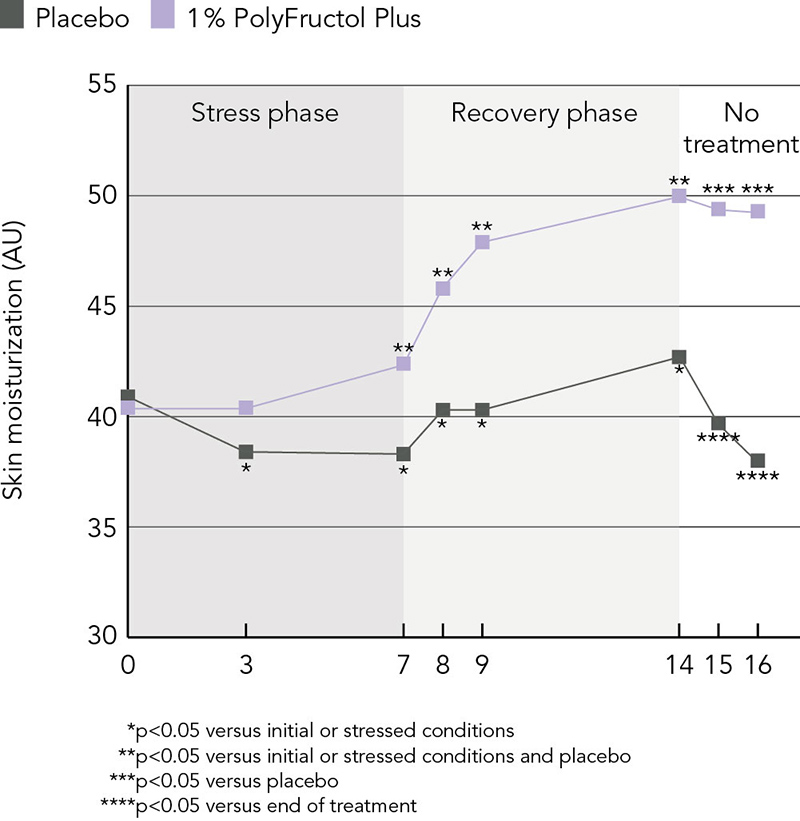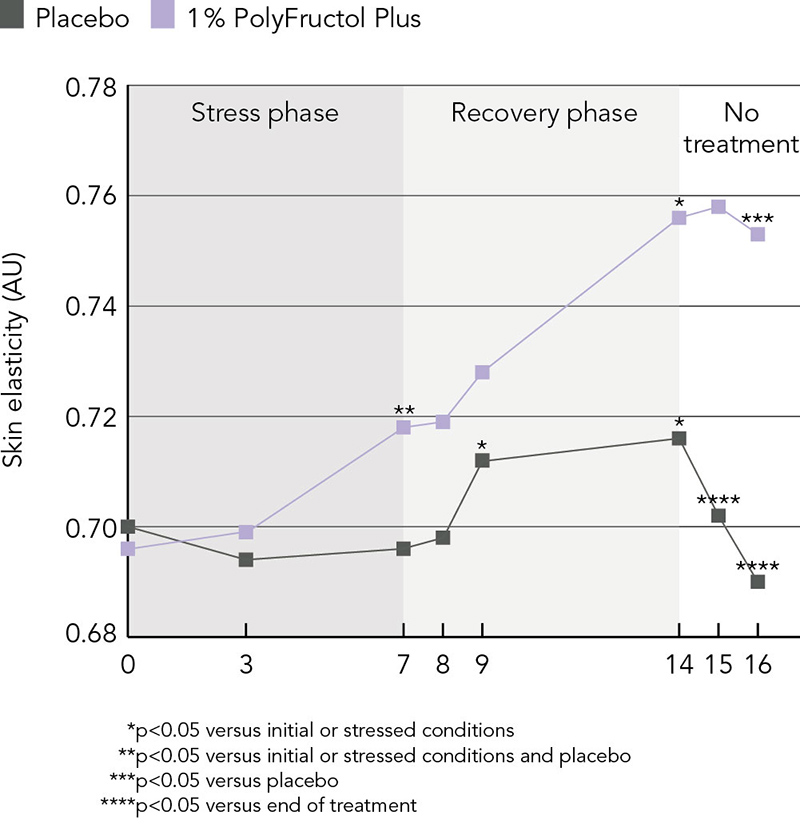Inulin is a natural substance produced by many vegetables and fruits. The roots of chicory (Cichorium intybus) are especially rich in inulin. Chicory is one of the most common wild herbs in Central Europe, which delights many people with its blue flowers.
It is an important medicinal and cultivated plant. Its leaves are used in salad while its roots are used as a substitute for coffee. The root component, inulin, is a polymer of the sugar fructose and it is known as a non-digestible dietary fibre with low caloric value.
Inulin is commonly used as a prebiotic, fat and sugar replacer, as well as for the development of functional foods, thanks to its beneficial role in gastric health.
Skin moisture balance
The formation of a permeability barrier starts in the lower epidermis where new keratinocyte cells are constantly produced. During migration to the outer epidermis, they transform into dead, keratinised cells (corneocytes).
Embedded in a lipid matrix, the corneocytes form the stratum corneum, which is a tight water barrier. Frequent washing of the skin with products containing surfactants can disturb the moisture balance. The surfactants solubilise the skin’s lipid matrix and ultimately lead to the wash out of skin lipids and humectants.

Blue-flowered chicory is one of the most common wild herbs in Central Europe
Skin microbiota: A barrier
Billions of microorganisms colonise the human skin at various sites and constitute the skin microbiota. They form complex communities that function together with the host immune system in order to defend against pathogens and to maintain skin health.
The most recent research has revealed the complexity of this field as the amount and type of microbes varies significantly between different subjects as well as between different skin areas within one person.
In general, it is believed that the broader the variety of microbes at a specific skin site, the better it is for the health of the skin.
Under normal conditions, the microbiotic film protects the skin against other harmful bacteria or pathogens. As it is the first barrier, this film is constantly stressed not only by factors such as UV light, pollution and domestic chemicals, but also by cosmetic products or treatments.
A skin humectant and prebiotic
Inulin is a humectant: it draws water from the environment into the skin, helping to keep it hydrated. In addition, it forms a smooth and pleasant film on the skin that acts as a skin conditioning agent, leaving the skin soft and smooth.
Due to prebiotic properties, ie nourishing a healthy bacterial flora, inulin helps to preserve the healthy appearance of the skin by balancing the skin’s microbiota.
Thanks to this quality, inulin enhances the natural protective barrier of the skin and maintains its good condition. Overall, a balanced skin microflora will result in improved moisture retention and a fuller, healthier skin.
Here, Mibelle Group Biochemistry describes the use of a partial hydrolysate of chicory root inulin (oligofructose) to moisturise and repair skin, which is stressed by a daily harsh washing procedure. For optimal skin bioavailability, the oligofructose is combined with lecithin liposomes (PolyFructol Plus; INCI: Inulin, glycerin, phenoxyethanol, lecithin, xanthan gum, aqua/water).
Study on stressed skin
PolyFructol Plus was tested in a clinical study with female volunteers aged from 18-60 years with normal to dry skin. The study encompassed a period of washing stress, a recovery phase and a no-treatment period at the end to verify a long lasting effect (figure 1).
Figure 1

Scheme of the clinical study design
During the first seven days, the volunteers had to wash their arms three times daily with a non-hydrating and non-grooming shower gel to impose a washing stress.
Each time, after washing and a short drying period, they applied on one forearm a cream with 1% PolyFructol Plus and the cream without active (placebo) on the other arm. Afterwards a recovery phase of seven days followed where the test products were applied twice daily in the morning and evening.
The following skin parameters were measured: hydration (Corneometer CM825), trans-epidermal water loss (TEWL) (Tewameter TM300), elasticity (Cutometer MPA580) and roughness (Antera 3D). Measurements were done before product application, on days three, seven, eight, nine, 14, and one and two days after the last product application.
The results showed for all the measured parameters the same tendency (figures 2 and 3 – the results of TEWL and roughness are not shown). During the stress phase skin conditions worsened in the placebo-treated skin area.
Figure 2

PolyFructol Plus protects against stress-induced moisture loss and stimulates gain of moisture during recovery
On the contrary, in the skin area treated with the cream containing PolyFructol Plus, skin conditions even slightly improved. During the recovery phase the skin conditions improved on both arms, but the improvement was clearly more pronounced in the skin treated with the PolyFructol Plus cream, especially for moisture (figure 2) and elasticity (figure 3).
The values of these two parameters stayed high even two days after the last product application in the skin treated with the active formulation, whereas there was a sharp drop in the placebo-treated skin.
Single application hydration
The oligofructose liposomes were tested at different concentrations in a shower product on 20 female volunteers aged from 26-49. They washed a defined area on the inner side of the forearms with a solution of water containing 20% shower gel with 5%, 0.1% and without oligofructose liposomes (placebo).
After 20 minutes, the test areas were rinsed with tap water. And 30 and 60 minutes after the application, skin hydration (Corneometer CM825) was measured.
Compared with an area only washed with water (untreated) all the tested shower products improved skin hydration (figure 4). But already the addition of only 0.1% oligofructose liposomes hydrated the skin much better.
Figure 3

PolyFructol Plus protects against stress-induced loss of elasticity and stimulates gain of elasticity during recovery
A further improvement of skin hydration was achieved with 5% of the active.
Conclusion
An active containing oligofructose combined with lecithin liposomes proved a strong hydration effect even in a rinse-off product after a single application.
Inulin, the source material for the oligofructose, has a long tradition in the food industry not only as functional fibre, but also as a humectant, a masker of bitter taste and as a fat replacer.
Topically applied, it forms a water-binding film with skin-conditioning effects.
Figure 4

PolyFructol Plus adds moisture even in a rinse-off product after a single application
Interestingly, in compromised skin, such as after excessive washing, the ingredient PolyFructol Plus also showed a protecting effect. This might be because of inulin’s prebiotic nature.
The oligofructose molecules are a perfect food source for the skin microbiota and help in recolonisation after washing. The skin microbiota plays an essential role in maintaining a healthy skin barrier.




